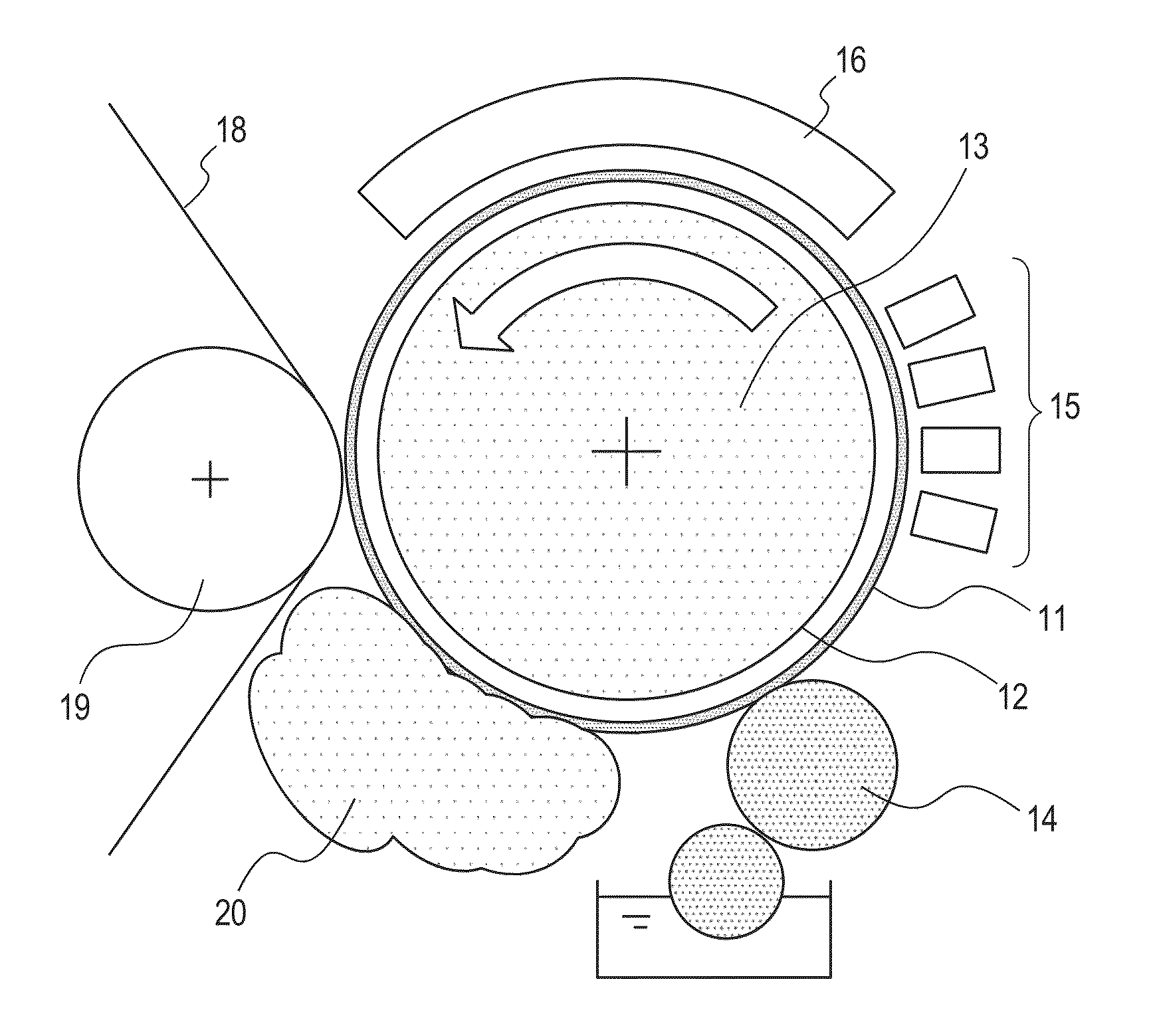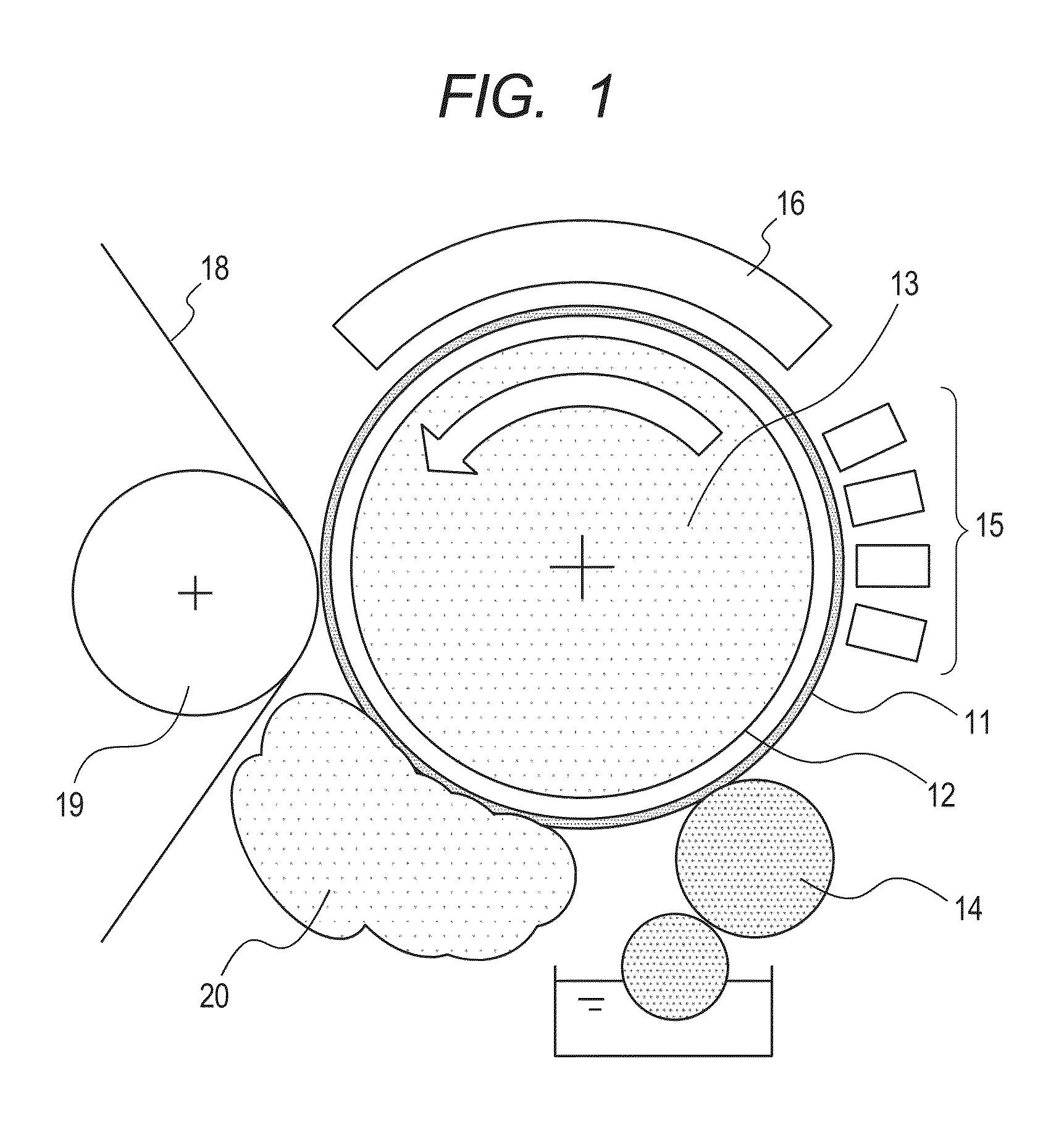Transfer image forming method, transfer image forming apparatus, and intermediate transfer member to be used therein
a technology of transfer image and forming apparatus, which is applied in the direction of typewriters, duplicating/marking methods, printing, etc., can solve the problems of transfer failure, curling and cockling, and insufficient investigation, and achieve the effect of improving the transferability and detachability of an intermediate image and more elasticity
- Summary
- Abstract
- Description
- Claims
- Application Information
AI Technical Summary
Benefits of technology
Problems solved by technology
Method used
Image
Examples
example 1
[0124]In this example, the transfer image forming apparatus illustrated in FIG. 1 was used. A member having the layer construction of FIG. 3 was used as the intermediate transfer member 11 of the transfer image forming apparatus. That is to say, in the intermediate transfer member 11, the surface layer (first layer), the metal layer, the heat insulating layer (second layer), the pressure relaxing layer, and the substrate 12 are placed in the stated order from the surface side of the intermediate transfer member 11. A cylindrical drum formed of an aluminum alloy was used as the substrate 12. Hereinafter, the construction of each layer on the substrate 12 is described.
[0125](i) Surface Layer (First Layer)
[0126]Used in this example was a surface layer obtained by coating a PET sheet having a thickness of 0.5 mm with a 0.2-mm thick layer of a silicone rubber having a rubber hardness of 40° (KE12 manufactured by Shin-Etsu Chemical Co., Ltd.); and then detaching the layer from the PET she...
example 2
[0137]The same apparatus as that of Example 1 was used except that the intermediate transfer member 11 was changed to the following member corresponding to that having the layer construction of FIG. 2.
[0138](i) Surface Layer (First Layer)
[0139]The same layer as that of Example 1 was used.
[0140](ii) Metal Layer
[0141]Gold having a thickness of 30 μm was used.
[0142](iii) Heat Insulating Layer (Second Layer)
[0143]Foamed polystyrene having a thickness of 0.5 mm (heat conductivity: 0.03 W / m·K) was used. Although no pressure relaxing layer is provided here, the heat insulating layer has elasticity because a foaming material is used in the layer. According to this construction, (heat conductivity) / (thickness) of the second layer is 60 (W / m2·K), which is a value smaller than (heat conductivity) / (thickness) of the first layer, i.e., 800 (W / m2·K).
example 3
[0144]The same apparatus as that of Example 1 was used except that the intermediate transfer member 11 was changed to the following member corresponding to that having the layer construction of FIG. 3.
[0145](i) Surface Layer (First Layer)
[0146]The same layer as that of Example 1 was used.
[0147](ii) Metal Layer
[0148]Gold having a thickness of 30 μm was used.
[0149](iii) Heat Insulating Layer (Second Layer)
[0150]Foamed polystyrene having a thickness of 0.1 mm (heat conductivity: 0.03 W / m·K) was used.
[0151](iv) Pressure Relaxing Layer (Third Layer)
[0152]An NBR having a thickness of 1 mm (heat conductivity: 0.2 W / m·K) was used.
[0153]According to this construction, (heat conductivity) / (thickness) of the second layer is 300 (W / m2·K), which is a value smaller than (heat conductivity) / (thickness) of the first layer, i.e., 800 (W / m2·K).
PUM
| Property | Measurement | Unit |
|---|---|---|
| surface temperature | aaaaa | aaaaa |
| temperature | aaaaa | aaaaa |
| temperature | aaaaa | aaaaa |
Abstract
Description
Claims
Application Information
 Login to View More
Login to View More - R&D
- Intellectual Property
- Life Sciences
- Materials
- Tech Scout
- Unparalleled Data Quality
- Higher Quality Content
- 60% Fewer Hallucinations
Browse by: Latest US Patents, China's latest patents, Technical Efficacy Thesaurus, Application Domain, Technology Topic, Popular Technical Reports.
© 2025 PatSnap. All rights reserved.Legal|Privacy policy|Modern Slavery Act Transparency Statement|Sitemap|About US| Contact US: help@patsnap.com



